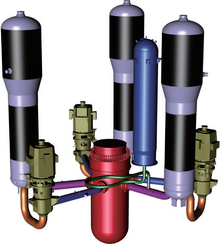Hualong One
Hualong One (also known as HPR1000 ) is a Chinese series of nuclear reactors. It is a pressurized water reactor with a net power of 1000 MW, which originally stems from the 3-loop Framatome design M310 , made a development step towards the CPR-1000 and was then further developed into a Generation III reactor with active and passive safety features .
history
China National Nuclear Corporation (CNNC) and China General Nuclear Power Group (CGN) both developed similar reactor concepts based on the French CPY series. CNNC has its roots as the Ministry of Nuclear Industry and was responsible for the early stages of military and civilian nuclear energy use in China before becoming CNNC in 1988. At the Qinshan nuclear power plant , reactors of the CNP series were tested; the last step was towards ACP1000. CGN grew up as an importer of French nuclear power technology in the Daya Wan / Ling'ao NPP . The further development of the CPR1000 to the ACPR1000 comprised a double-shell containment and a core catcher.
China's NEA (National Energy Administration) instructed the two companies in 2011 to merge their respective developments in the direction of G3 reactors. Both concepts were quite similar, but differed e.g. B. in the reactor core, which had different numbers and different lengths of fuel elements. The result is the Hualong One development, in which the CNNC concept was agreed with regard to the core, but z. B. allowed minor differences in security measures. CNNC development was influenced by the Westinghouse AP1000 model and CGN was based on Areva's EPR. In December 2015, CNNC and CGN formed a joint venture, Hualong International Nuclear Power Technology Co, to market the Hualong One design internationally.
Technical specifications
The nuclear reactor has a thermal output of 3050 MW with 177 fuel elements. It has an electrical efficiency of approx. 36%, resulting in a net output of around 1090 MW. The power plant is suitable for both base load and load follow-up operation and was designed for a service life of 60 years. The fuel element replacement cycle is 18 months.
The reactor is supposed to withstand earthquakes with an acceleration of up to 0.3 g and is equipped with a double containment to protect against airplane crashes. So that major incidents do not escalate, the power plant is equipped with a combination of active and passive mechanisms for heat dissipation, which allow the operating team not to intervene directly for up to 30 minutes and the power plant for up to 3 days (72 h) without assistance can withstand the outside.
Target costs for construction in the home market of China are 2800-3000 USD / kW, although estimates range up to 3500 USD / kW. According to CGN, the CAPEX of a series construction is 17,000 CNY / kW (2,650 USD / kW) - compared to 13,000 CNY / kW for second generation reactors.
Locations
In China, the Hualong One will be realized at the Fuqing NPP (blocks 5 and 6) and at the Fangchenggang NPP (blocks 3 and 4), construction of the first block was started in May 2015. Commissioning is expected in 2020, Fuqing 5 completed the hot- Test in March 2020. Two more Hualong One each are planned for the new Zhangzhou NPP (construction started in October 2019) and Huizhou (final permit received), as well as for the Changjiang NPP (units 3 and 4).
The reactor type is also exported, in Pakistan two units are under construction in the Karachi NPP (Units 2 and 3), one unit in the Chashma NPP (Unit 5) is being planned, projects in Argentina and Great Britain are under discussion.
Individual evidence
- ↑ Ji Xing, Daiyong Song, Yuxiang Wu: HPR1000: Advanced Pressurized Water Reactor with Active and Passive Safety . In: Engineering . tape 2 , no. 1 , March 2016, p. 79-87 , doi : 10.1016 / J.ENG.2016.01.017 .
- ^ A b Nuclear Power in China # Hualong One - HPR1000. In: www.world-nuclear.org. World Nuclear Association, December 2019, accessed December 31, 2019 .
- ↑ Ji XING, Daiyong SONG, Yuxiang WU: HPR1000: Advanced PWR with Active & Passive Safety Features. IAEA, June 6, 2017, accessed December 31, 2019 .
- ↑ Hot tests completed at Fuqing March 5, 2020, accessed April 29, 2020 .
- ↑ First concrete for China's Zhangzhou October 1st, 22nd, 2020, accessed on April 29th, 2020 .
- ↑ Hualong reactors replace AP1000s in Chinese nuclear plans. February 8, 2019, accessed April 29, 2020 .
- ^ Progress at Pakistan's Karachi nuclear power plant. February 20, 2020, accessed April 29, 2020 .
- ^ Another Hualong One for Pakistan. November 27, 2017, accessed April 29, 2020 .

